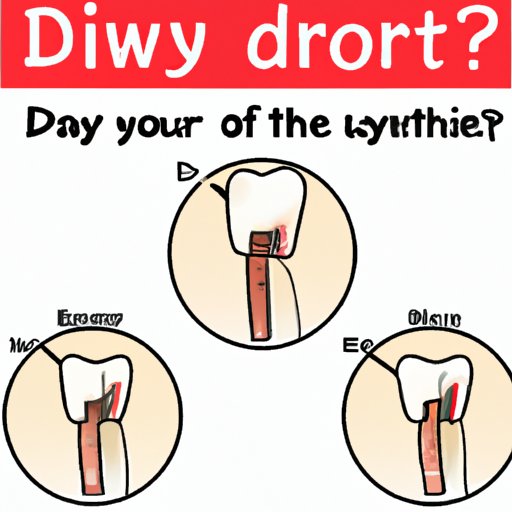Introduction
If you have had a tooth extraction, you may have heard of dry socket. This is a painful condition that can occur after a tooth extraction. It happens when the blood clot that forms in the tooth socket is dislodged or dissolves before the wound has healed, exposing the bone and nerves. This article aims to provide you with valuable information on how to identify dry socket, and how to prevent and treat it.
Symptoms of Dry Socket
Dry socket is identifiable through its characteristic symptoms. These symptoms include:
Pain and discomfort around the extraction site
The most common symptom of dry socket is pain. It is usually more severe and persistent than the usual pain after a tooth extraction. The pain may radiate to your ear, eye, and neck on the same side as the affected tooth.
Foul taste or odor in the mouth
In some cases, dry socket may cause bad breath or a foul taste in the mouth. This is usually a sign that there is an infection in the area. If you notice a bad taste or smell after a tooth extraction, you should consult your dentist immediately.
Visible changes in the extraction site
The blood clot that forms after a tooth extraction protects the wound and helps it heal. If you have dry socket, the clot may be missing or appear dislodged. You may also notice exposed bone in the socket, which can be a sign of a serious infection.
Causes and Risk Factors of Dry Socket
Several risk factors can increase the chances of developing dry socket. These include:
Age, oral hygiene, and smoking as primary culprits
Studies show that people over the age of 30, those who have poor oral hygiene, and those who smoke are more likely to develop dry socket. This is because these factors can slow down the healing process and increase the risk of infections.
Insights on preventive measures to reduce these risks
To reduce the risks of developing dry socket, you can take preventive measures such as practicing good oral hygiene, quitting smoking before the procedure, avoiding drinking from a straw, and biting down on gauze for the recommended time after the extraction.
Prevention Tips for Dry Socket
The best way to avoid dry socket is to follow preventive measures before and after your tooth extraction. Here are some tips:
Pre and post-operative care procedures to prevent dry socket
Your dentist will provide you with pre-operative guidelines to follow before the extraction. You will be advised to avoid alcohol and smoking for at least 24 hours before the procedure, and to eat a light meal before the extraction. After the procedure, you should avoid alcohol, hot food or drinks, or anything that can make you spit or rinse your mouth vigorously. You should also avoid physical activities for a few days.
Proper oral hygiene practices
Good oral hygiene is essential before and after a tooth extraction. You should brush your teeth carefully and gently around the extraction site and floss gently to keep the area clean. Avoid using mouthwash or other medicated rinses, as these can irritate the site and prevent the blood clot from forming.
Nutritional guidelines to help with recovery
Your body needs nutrients to heal efficiently. You should eat a healthy diet rich in vitamins and minerals to help with recovery. Avoid hard and crunchy foods that can irritate the extraction site.
Tips for avoiding smoking and other harmful habits during recovery
Smoking can affect the healing process and increase the risk of developing dry socket. You should avoid smoking for at least 48 hours after the procedure.
Treatment Options for Dry Socket
There are several treatment options available for people suffering from dry socket. These include:
Over-the-counter options such as pain relievers and natural remedies
Over-the-counter pain relievers such as acetaminophen, ibuprofen, or aspirin can help relieve the pain associated with dry socket. You can also try natural remedies such as clove oil or rinsing your mouth with salt water.
Prescription medications such as antibiotics and anti-inflammatory drugs
If the pain and inflammation are severe, your dentist may prescribe antibiotics or anti-inflammatory drugs to help reduce the inflammation and prevent an infection from occurring.
How Dentists Diagnose Dry Socket
To diagnose dry socket, your dentist will evaluate your symptoms, personal history and lifestyle. They may also perform a diagnostic test on the affected area, such as:
Visual inspection and imaging techniques such as x-rays used by dentists
Your dentist will examine the extraction site for any visible changes or signs of infection. They may also take an X-ray to check for any bone exposure or other complications.
Complications and Long-Term Effects of Dry Socket
Dry socket can lead to serious complications if left untreated. These complications include:
Infections and chronic pain caused by untreated dry socket
If the exposed bone in the affected area is not covered and protected, bacteria can enter the socket and cause an infection. This can lead to a more severe condition known as osteomyelitis, which can cause chronic pain and require extensive treatment.
Ways to prevent these complications from happening
The best way to prevent these complications is to follow the preventive measures mentioned earlier and to seek medical attention immediately if you suspect you have dry socket. Your dentist can clean the affected area and prescribe medication to prevent further infection or complications.
Conclusion
In summary, dry socket is a painful condition that can occur after a tooth extraction. Its symptoms include pain, foul taste or odor in the mouth, and visible changes in the extraction site. To prevent it, you can practice good oral hygiene, avoid smoking, and follow pre and post-operative care tips. If you develop dry socket, seek medical attention immediately to prevent further complications.
If you follow the guidelines in this article and seek the advice of your dentist, you can minimize the risks and symptoms of dry sockets and ensure a speedy and safe recovery.
